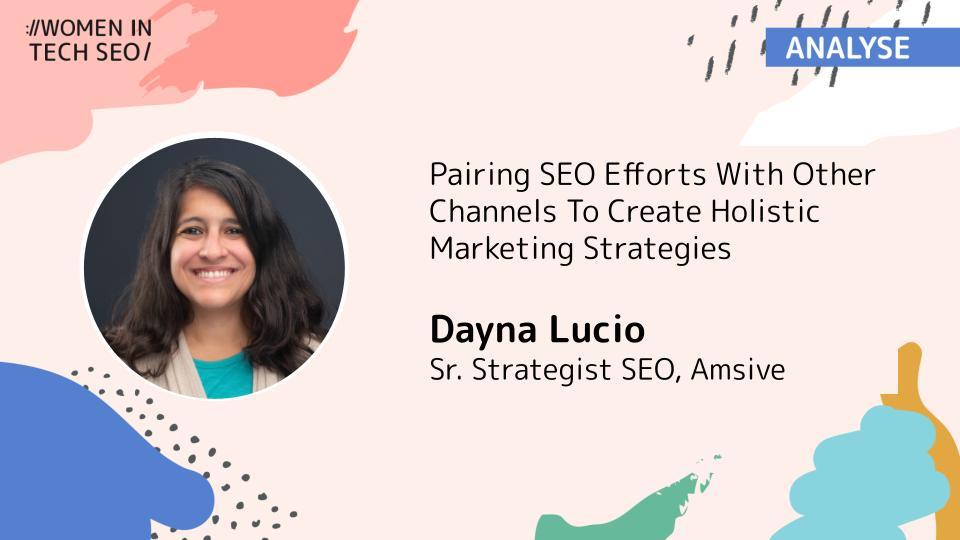👕 WTSMerch now available
🎟️ WTSFest 2026 tickets on sale for London, Portland, & Philadelphia
👕 WTSMerch now available
🎟️ WTSFest 2026 tickets on sale for London, Portland, & Philadelphia

Author: Dayna Lucio
Last updated: 13/09/2024

Now more than ever, gaining traffic, conversions, and long-term customers is challenging. We are long past the days when Google’s search results page (SERPs) were primarily organic links and a couple of additional search features. For many searches now, competition is fierce, with AI overviews, multiple search features, and prominent advertising features, it’s easy to get lost in the mix.
As SEOs and marketers, it’s important to understand that marketing shouldn’t be single channel-centric. Creating a holistic marketing strategy that can reach users at different touchpoints in their journey is the best way to get in front of audiences and support business goals.
Not only can SEO work more effectively when paired with other channels, but other channels can utilize the research and data from organic search efforts to help understand what customers are searching for, what content they are engaging with, and more.
The SERPs provide a first impression of your brand. A simple search of your brand name can help you identify potential questions customers may have about your brand, and identify opportunities to improve brand reputation and visibility.

Image of Google search results for Peacock featuring popular movies and TV shows, highlighting their titles and ratings.
Questions to ask when looking at brand SERP results:
Getting a general understanding of online sentiment and visibility can help businesses identify strengths and areas for improvement.

Google search results page feature People Also Ask showing common questions about Southwest Airlines such as cost or assignments.
Monitor the People Also Ask SERP feature for branded queries to understand what questions users are asking about your brand. Keyword research tools like SEMRush will allow you to see what queries your domain owns and doesn’t own. This can help businesses identify the questions that people are asking about their brand where they don’t own the answer, but other sites do, potentially leading to misinformation.
There are multiple places on your website where you can leverage PAA content:
Trying to write content around PAAs gives your business a chance to contribute to the narrative and be a source of truth for questions related to your business. Additionally, non-branded PAAs can be a great way to find new topics for blog content.
Search behavior data enables businesses to understand their audience's interests, preferences, and pain points, empowering them to tailor content and on-site experiences. Understanding the information available about your business is important, but it's also important to understand how users will find your business when making decisions about brand messaging or website copy.
Numerous times, I have encountered the issue of seeing a client's site talk about their product, which has used a branded product name but has yet to include any copy about what the product actually is. For example, if you're a retailer that sells athletic wear, you should call your running shoes exactly what they are: running shoes rather than running sneakers or sports shoes. Stay aligned with what users search for when marketing your products online.
For users who are unfamiliar with your brand, sometimes you have to go back to basics and explain exactly what you're offering. You also have to optimize for the key terms users are searching for in your metadata, headlines, and on-page copy to ensure that you're showing up for the right search queries.
Additionally, I recommend that clients examine the language their competitors use to describe their products or services. What keywords are they using? How are they describing themselves? What questions are they answering? By analyzing search queries and user behavior, businesses can identify trends that enable them to create relevant and valuable content that addresses user needs.
Keyword data can be analyzed and used in multiple ways to benefit SEO efforts and paid search performance. Having access to this type of data can allow businesses to understand search behavior and identify gaps in strategies being used for either channel.
Teams can utilize organic data, such as keyword rankings or information from Google Search Console, to show which keywords rank highly in organic search, and drive traffic to their websites. Seeing which keywords perform well via organic search can help paid teams uncover potential areas for cost savings by adjusting bidding on keywords that are already performing well organically, and either reallocating that budget to different keyword groups, or saving the budget altogether.
In a similar vein, Google Ads data can show which keywords are driving traffic, impressions, and conversions from paid campaigns, alongside the associated costs. When looking at this data alongside organic keyword rankings, there is the opportunity to identify keywords that drive clicks and conversions via paid search, but don’t rank well organically. This data can be used to enhance SEO efforts by helping identify gaps in content, and showing areas where the website may be underperforming organically. Paid search performance data can provide valuable insights for keyword targeting, which can be used for planning new content or upcoming content optimizations to improve organic rankings to drive more organic traffic for high-converting and high-value keywords.

Google search results page showing a business listing with reviews, location, and phone number prominently featured.
In some instances, rather than seeking to make cost savings, pairing SEO and PPC can help to improve search visibility by owning more real estate on the SERP. Targeting branded keywords with paid search minimizes your competitors' ability to steal attention (and clicks) away from your website.
Similarly, achieving organic rankings and running PPC campaigns for non branded keywords gives you additional visibility to your target customers. When your business appears in both the paid and organic results, it gives your brand multiple chances to attract clicks. You can also use paid campaigns to test the impact of different ad copy to improve click-through rates.
Organic search, coupled with paid strategies can enable you to target customers at different customer journey stages, from research, to comparison, to conversion. Various online content optimized for SEO can help reach different audiences, especially at the start of their journey.
Remarketing campaigns can also be built for both paid search and paid social to target different users with different messages and imagery. Remarketing can help you stay in front of potential customers who have visited your site via organic search with customized messaging to bring them back and lead them to conversion.

Facebook ad promoting a meal plan delivery service with meal examples
SEO can help to inform social messaging and vice versa. Social media allows your brand to build relationships with potential and current customers which helps to create authentic engagement. Not only can social media be an opportunity to test messaging with your audience before committing to long-term usage on your website, but social channels can be used to promote the content that you’re creating to a wider audience.
The social media team can leverage the content being made on your website and showcase that content in a different format to understand what drives engagement. Blog posts can be turned into shareable infographics or video snippets. Quotes from your authors, team leaders, or online experts can be repurposed into graphics or gifs and circulated across different platforms.
Additionally, through social media, businesses can continue to engage with their customers long after they’ve converted. Creating an engaging and positive experience with customers can lead them back to you when they are in the market for products or services again, which turns customers into long-term supporters of your brand or even brand advocates.
Monitoring social media topics related to your brand on platforms like X or TikTok can help identify topics that potential customers are interested in, and discussing. Social media can give insight into real-time trends and reactions from users, which could be turned into long-form content articles, giving your brand the opportunity to create content before competitors.

FitOn Email showing 70% off Promo With Athletes Training
I can't count the times I've been in conversations where the metrics we determined to be solid KPIs for SEO were improving, and yet, we still weren’t able to meet our business goals. One example of this happening is in a membership-based business (think gyms, spas, etc.) where free trials or special promotions are offered. Yes, SEO may be driving online visibility, new users to the site, ranking for all the right keywords and even driving some conversions on your free trial form. However, it often takes more than a free trial to convert someone into a monthly member - which is the long-term goal of the business.
Pairing marketing efforts like paid, social, and SEO with email marketing can help nurture leads into becoming long-term customers.
SEO and email marketing can work hand-in-hand. Strong organic search efforts can help drive new customers to the site, increase awareness around your business, and answer users' questions. Email marketing allows businesses to go the extra step and engage with users who have already shown interest in products or services, whether this is through newsletters or campaigns based on user interactions. Additionally, understanding what type of content users actively engage via email can help with topical research and give insight into what content best connects with target audiences.
We've all heard the saying, 'There's no I in team.' Well, as cliche as it sounds, it still rings true, and the same theory applies to marketing. Although there might be some competition between channels, the most effective marketing strategies (i.e. the ones that get results) typically come from a multi-channel approach.
To get things started, set up a meeting with other departments (email marketing, social media, paid search, etc) to understand their goals, challenges, and the current strategies they have in place. Once everyone is on the same page it will be easier to identify potential areas for collaboration which will help you all achieve your goals.
For example, if the paid team has been running ads for the past year, ask them what headlines get the most clicks or are seeing the highest click-through rate. Those headlines could then be compared to current headlines or metadata on the website. If something isn’t working on site this could be an opportunity to leverage what is working in paid as an organic test. Another example would be to talk to the social team to get an idea of what posts have performed the best, perhaps those could be repurposed as a GBP post for a local business or the topic could help spur ideas for the early phases of on-site content planning.
Sometimes we can get so focused on our own initiatives and results, that we forget about the bigger picture. Now’s the perfect time to start looking for new approaches and see what opportunities there are available to take advantage of.